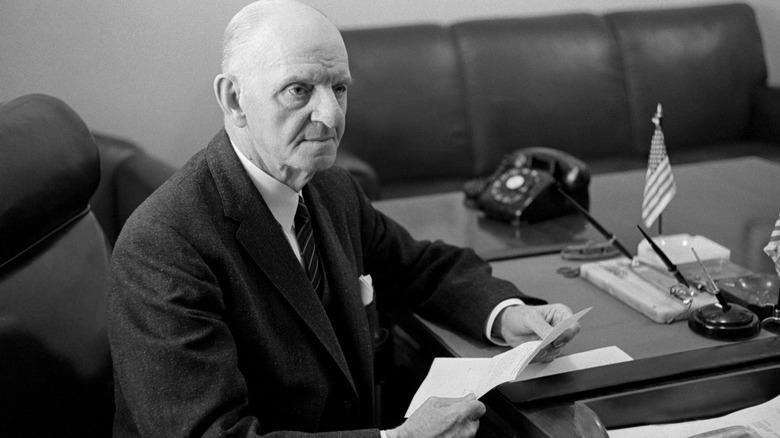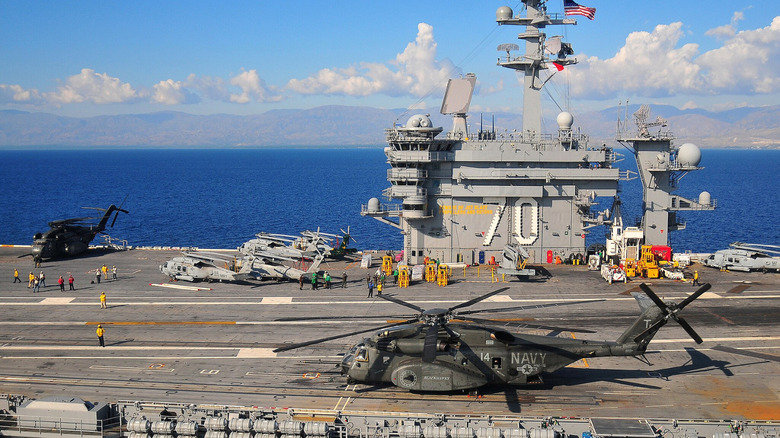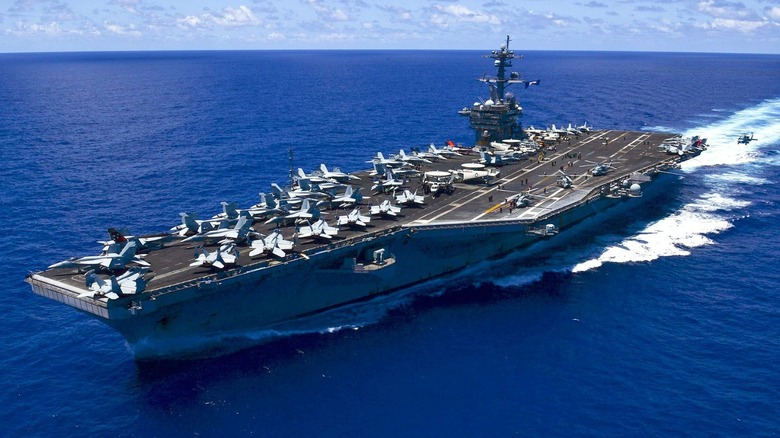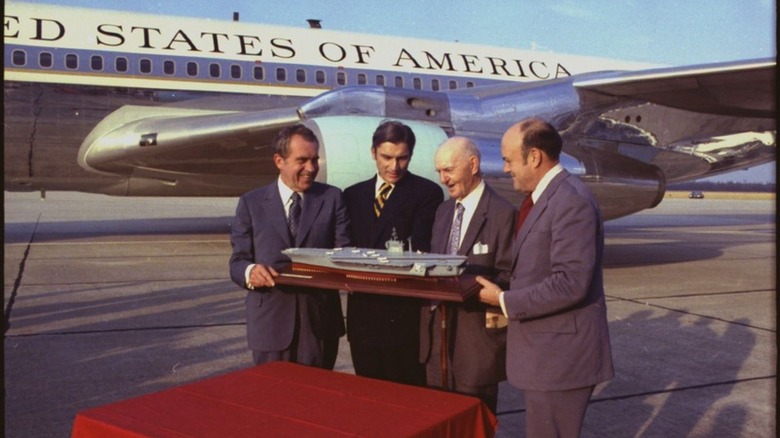Who Was Carl Vinson And Why Does He Have An Aircraft Carrier Named After Him?
Launched on March 15, 1980, the USS Carl Vinson (CVN-70) joined the U.S. Navy's nuclear-powered supercarriers. She became the third and final Nimitz-class supercarrier, joining the Dwight D. Eisenhower and the flagship vessel named for the Navy's fleet admiral and commander of the Pacific Fleet during World War II, Chester W. Nimitz. While history classes are likely to at least touch on who Nimitz and Eisenhower were, Carl Vinson, after whom the CVN-70 supercarrier was named, is likely to escape most young (and likely some older) Americans.
The supercarrier may be recognizable as the vessel featured in the 2001 war film "Behind Enemy Lines," or for leading the initial airstrikes of Operation Enduring Freedom and transporting Osama bin Laden's body to his sea burial. Unfortunately, the man she was named after had long since passed away and missed out on the carrier's glory.
Born in 1883, just two years before Nimitz, Vinson became known as the "father of the two-ocean navy" and served a long and impressive political career that lasted through his retirement in 1965. In that time, Vinson earned a U.S. Navy ship named in his honor, though it wasn't commissioned into service until 1982, just a year after his death.
Carl Vinson's early political career
In 1912, 29-year-old Carl Vinson suffered the only political defeat of his career after spending two terms in the Georgia House of Representatives. After his loss in 1912, the then-governor overseeing Baldwin County appointed him judge, a position Vinson wouldn't be in for long. After the passing of U.S. Senator Augustus Bacon in 1913 and the representative from Georgia's 10th congressional district resigned to fill the now-empty seat, Vinson saw an opportunity to claim a spot in the federal government.
Running against three opponents who were better known for their wealth than their political standings, Vinson secured an easy victory. When he was sworn in on November 3, 1914, he became the youngest member of Congress. The young House member remained in his seat throughout World War I, eventually moving to the Naval Affairs Committee at the close of The Great War. Despite having no ties to the military prior to his new assignment, Vinson quickly became an advocate for stronger national defenses.
[Featured image by U.S. Navy via Wikimedia Commons | Cropped and scaled | CC BY-SA 3.0]
Vinson and the lead-up to World War II
In the aftermath of World War I, leading nations sought a more peaceful existence. Both the Washington Treaty of 1922 and the London Treaty of 1930 focused on naval armaments, with nations like the United States, Japan, France, and Italy agreeing to temporarily halt the production of warships critical to any war effort. Along with limitations on aircraft carriers, implemented during the Washington Conference, the U.S., Japan, and Great Britain agreed to reduce battleship tonnage at the London Naval Conference. Back in the States, one man was vehemently against the signing of either treaty: Carl Vinson.
As part of the Naval Affairs Committee, Vinson made it his goal to increase the power of the U.S. Naval fleet. Though he protested the limitations to presidents Harding, Coolidge, and Hoover, it wasn't until Franklin Roosevelt's term in office during the 1930s that Vinson received the support he needed. As co-author of the Vinson-Trammell Act with Florida Senator Park Trammell, Vinson became the father of the nation's two-ocean navy, a fully equipped fleet capable of defending itself against foreign invaders from both sides of the world. Incidentally, it came at a crucial time as, shortly after, war erupted in Europe and later crept its way into the Pacific.
[Featured image by U.S. Navy via Wikimedia Commons | Cropped and scaled | CC BY-SA 3.0]
The father of the two-ocean navy
With the Vinson-Trammel Act passed, the United States Navy began development of a sizable fleet, including three aircraft carriers and more than 60 different support and battle-ready vessels. When war broke out with Japan in the Pacific, the U.S. Navy had 15 battleships commissioned and ready for battle. With critical Allied victories at the Battle of Midway and the Battle of Leyte Gulf, it's difficult to deny that Vinson's determination to strengthen the U.S. Navy was a significant factor in the outcome of the War in the Pacific.
When World War II ended, President Truman merged all military factions under a secretary of defense, a position he tried on multiple occasions to get Vinson in. Vinson declined, instead preferring to "... keep running the Pentagon from up here." He served as an Armed Services Committee member for two years and became its chairman in 1949.
Over his 30-year career as a politician, Vinson proved vital to the development of the U.S. Navy. To honor his role in preparing the nation for the oceanic warfare of World War II and his long career as a politician, the Navy honored him with the USS Carl Vinson. Though he didn't live long enough to see it set sail, the vessel continues to pay tribute to the career politician and the impact he had on the nation's modern two-ocean navy.
[Featured image by Jack E. Kightlinger via Wikimedia Commons | Cropped and scaled | CC BY-SA 3.0]



